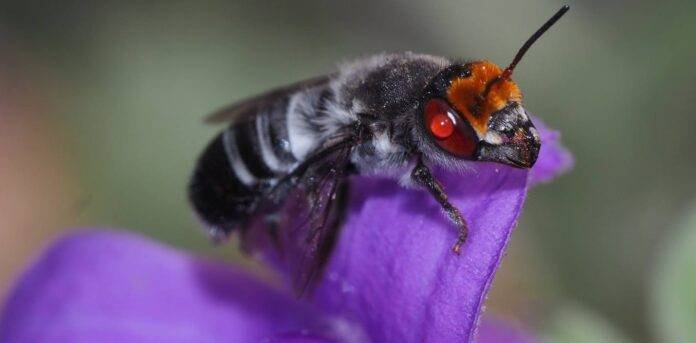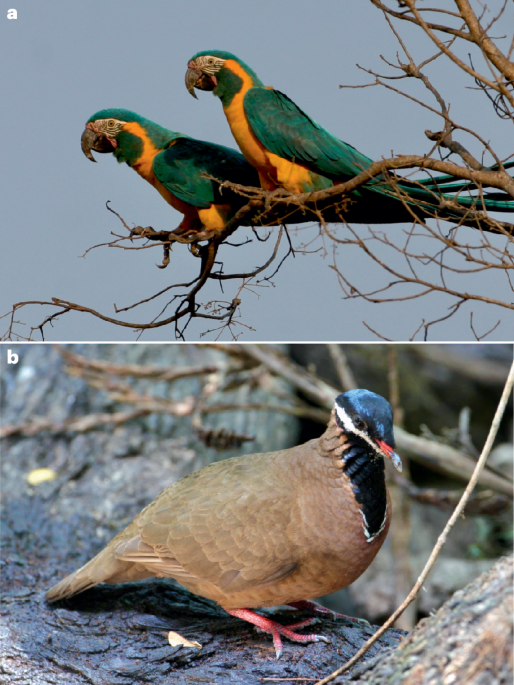Ceballos, G. et al. Accelerated modern human–induced species losses: entering the sixth mass extinction. Sci. Adv. 1, 1400253 (2015).
Mittermeier, R. A., Turner, W. R., Larsen, F. W., Brooks, T. M. & Gascon, C. Global biodiversity conservation: the critical role of hotspots. in Biodiversity Hotspots: Distribution Prot. Conserv. Prior. Areas 3–22 (2011).
Myers, N., Mittermeier, R. A., Mittermeier, C. G., Fonseca, G. A. & Kent, J. Biodiversity hotspots for conservation priorities. Nature 403, 853–858 (2000).
Hanson, T. et al. Warfare in biodiversity hotspots. Conserv. Biol. 23, 578–587 (2009).
Mendiratta, U., Osuri, A. M., Shetty, S. J. & Harihar, A. Mammal and bird species ranges overlap with armed conflicts and associated conservation threats. Conserv. Lett. 14, 12815 (2021).
McNeely, J. A. Conserving forest biodiversity in times of violent conflict. Oryx 37, 142–152 (2003).
Hart, T. et al. Conservation and civil strife: two perspectives from central Africa. Conserv. Biol. 11, 308–314 (1997).
Hilario-Husain, B. A. et al. Caught in the crossfire: biodiversity conservation paradox of sociopolitical conflict. Npj Biodivers. 3, 10 (2024).
Beyers, R. L. et al. Resource wars and conflict Ivory: the impact of civil conflict on elephants in the Democratic Republic of Congo – the case of the Okapi reserve. PLoS ONE. 6, 27129 (2011).
Jhala, Y. V., Mungi, N. A., Gopal, R. & Qureshi, Q. Tiger recovery amid people and poverty. Science 387, 505–510 (2025).
Poole, J. & Granli, P. The Gorongosa elephants through war and recovery: tusklessness, population size, structure and reproductive parameters. Pachyderm 63, 38–54 (2022).
Goswami, R. & Ganesh, T. Carnivore and herbivore densities in the immediate aftermath of Ethno-Political conflict: the case of Manas National park, India. Trop. Conserv. Sci. 7, 475–487 (2014).
Ling, L. E. & Ariffin, M. Abd Manaf, L. Threats to the conservation of Asian elephants: A review study. J. Gov. Dev. (JGD. 12, 123–139 (2016).
Duangchantrasiri, S. et al. Rigorous assessment of a unique tiger recovery in Southeast Asia based on photographic capture-recapture modeling of population dynamics. Global Ecol. Conserv. 53, 03016 (2024).
Rostro-García, S. et al. Population dynamics of the last Leopard population of Eastern Indochina in the context of improved law enforcement. Biol. Conserv. 283, 110080 (2023).
Jhala, Y. V., Qureshi, Q. & Nayak, A. K. Status of Tigers, Co-Predators and Prey in India 2018 (National Tiger Conservation Authority, Government of India, 2020).
Qureshi, Q., Jhala, Y. V., Yadav, S. P. & Mallick, A. Status of Tigers, Co-Predators and Prey in India, 2022 (National Tiger Conservation Authority, Government of India, New Delhi, and Wildlife Institute of India, 2023).
Bora, J. K. et al. Evaluating the potential for reintroducing the endangered wild water Buffalo (Bubalus arnee) in Kanha National park, central India. Restor. Ecol. 32, e14079 (2024).
Ghosh, S. et al. Survey for Endangered Grassland Species in Manas National Park. (2014).
Nath, A., Sinha, A., Lahkar, B. P. & Brahma, N. In search of aliens: factors influencing the distribution of Chromolaena odorata L. and Mikania micrantha Kunth in the Terai grasslands of Manas National park, India. Ecol. Eng. 131, 16–26 (2019).
Borah, J. et al. Tigers in the transboundary Manas conservation complex: conservation implications across borders. Int. J. Protected Areas Conserv. 19, 51 (2013).
Nath, A. et al. Breaking Dawn: factors influencing mammalian habitat usage in Western Assam following socio-political instability. J. Nat. Conserv. 72, 126357 (2023).
Lahkar, D., Ahmed, M. F., Begum, R. H., Das, S. K. & Harihar, A. Responses of a wild ungulate assemblage to anthropogenic influences in Manas National park, India. Biol. Conserv. 243, 108425 (2020).
Ghosh, S. & Kumar, C. Paradise lost and regained: lessons from the National parks of India. Online J 3, (2012).
K Sarma, P. et al. Land-use and land-cover change and future implication analysis in Manas National park, India using multi-temporal satellite data on JSTOR. Curr. Sci. https://www.jstor.org/stable/24103050 (2008).
Islam, N. et al. Revival of Eastern swamp deer Rucervus duvaucelii ranjitsinhi (Groves, 1982) in Manas National park of Assam, India. J. Threatened Taxa. 14, 20488–20493 (2022).
Bhatt, U. M., Habib, B. & Lyngdoh, S. Chital: photographic evidence of Axis axis after two decades in Manas National park, Assam, India. ZOO’S PRINT. 33, 5–8 (2018).
Kalita, P. After 34 yrs of armed struggle, NDFB finally disbands itself. (2020).
Lahkar, D. et al. Post-conflict recovery of Tigers (Panthera tigris) in a transboundary landscape: the case of Manas National park, India. Biol. Conserv. 300, 110837 (2024).
Jhala, Y. V., Qureshi, Q. & Gopal, R. The Status of Tigers, Co-Predators & Prey in India 2014 (National Tiger Conservation Authority, New Delhi & Wildlife Institute of India, 2015).
Jhala, Y. V., Qureshi, Q. & Yadav, S. P. Status of Leopards, Co-Predators, and Megaherbivores in India, 2018 (National Tiger Conservation Authority, New Delhi & Wildlife Institute of India, 2021).
Qureshi, Q., Jhala, Y. V., Yadav, S. P. & Tiwari, V. R. Status of Leopards in India (National Tiger Conservation Authority, New Delhi & Wildlife Institute of India, 2024).
Noss, R. F., Quigley, H. B., Hornocker, M. G., Merrill, T. & Paquet, P. C. Conservation biology and carnivore conservation in the Rocky mountains. Conserv. Biol. 10, 949–963 (1996).
IUCN. IUCN Green Status of Species: A Global Standard for Measuring Species Recovery and Assessing Conservation Impact. vol. Version 2.0. IUCN, (2021).
Jhala, Y. V. et al. Recovery of Tigers in India: critical introspection and potential lessons. People Nat. 3, 281–293 (2021).
Champion, H. G. & Seth, S. K. A Revised Survey of the Forest Types of India (Manager of, 1968).
Bhatt, U. M., Adhikari, B. S. & Lyngdoh, S. Monitoring diversity and abundance of mammals with camera-traps: a case study of Manas National park, Assam, India. Check List 18, (2022).
Manas Field Directorate. Tiger Conservation Plan, Manas Tiger Reserve: 2014–2024. (2019).
Buckland, S. T., Rexstad, E. A., Marques, T. A. & Oedekoven, C. S. & others. Distance Sampling: Methods and Applications. vol. 431Springer, (2015).
Awasthi, N. et al. Effect of human use, season and habitat on ungulate density in Kanha tiger reserve, Madhya Pradesh, India. Reg. Environ. Change. 16, 31–41 (2016).
Jhala, Y. V., Qureshi, Q., Gopal, R. & Field Guide: Monitoring tigers, co-predators, prey and their habitats. (2021).
Esri Inc. ArcMap. (2020). Available at: https://desktop.arcgis.com/en/
Wildlife Institute of India & National Tiger Conservation Authority. MSTrIPES. (2021). Available at: https://wii.gov.in/mstripes_mobile_app
Thomas, L. et al. Distance software: design and analysis of distance sampling surveys for estimating population size. Journal of Applied Ecology 47, 5–14 (2010). Available at: https://distancesampling.org/software/downloaddistwin.html
Buckland, S. T. et al. Introduction To Distance Sampling: Estimating Abundance of Biological Populations (Oxford University Press, 2001).
Burnham, K. P. & Anderson, D. R. Model Selection and Multimodel Inference: A Practical Information-Theoretic Approach (Springer-, 2002).
Manas Field Directorate. Swamp Deer Estimation, Manas National Park and Tiger Reserve. (2023).
Manas Field Directorate. Rhino Estimation Report 2022, Manas National Park and Tiger Reserve. (2022).
Williams, B. K., Nichols, J. D. & Conroy, M. J. Analysis and Management of Animal Populations: Modeling, Estimation, and Decision Making (Academic, 2002).
Kumar, U., Awasthi, N., Qureshi, Q. & Jhala, Y. V. Do conservation strategies that increase tiger populations have consequences for other wild carnivores like leopards? Sci. Rep. 9, 14673 (2019).
Hunter, L. Wild Cats of the World (Bloomsbury Publishing, 2015).
Hiby, L. et al. A tiger cannot change its stripes: using a three-dimensional model to match images of living tigers and tiger skins. Biol. Lett. 5, 383–386 (2009). Available at: https://conservationresearch.org.uk/Home/ExtractCompare/Tigers.html
Karanth, K. U. & Nichols, J. D. Estimation of tiger densities in India using photographic captures and recaptures. Ecology 79, 2852–2862 (1998).
Borchers, D. L. & Efford, M. G. Spatially explicit maximum likelihood methods for Capture-Recapture studies. Biometrics 64, 377–385 (2008).
Efford, M. G. Estimation of population density by spatially explicit capture–recapture analysis of data from area searches. Ecology 92, 2202–2207 (2011).
Efford, M. G. & secr Spatially explicit capture-recapture models. R package version 4.6.5, (2024). https://CRAN.R-project.org/package=secr
Jhala, Y. V., Gopal, R. & Qureshi, Q. Status of the Tigers, Co-predators, and Prey in India (National Tiger Conservation Authority, New Delhi & Wildlife Institute of India, 2008).
Goswami, V. R. et al. Towards a reliable assessment of Asian elephant population parameters: the application of photographic Spatial capture–recapture sampling in a priority floodplain ecosystem. Sci. Rep. 9, 8578 (2019).
Jathanna, D. et al. Reliable monitoring of elephant populations in the forests of India: analytical and practical considerations. Biol. Conserv. 187, 212–220 (2015).
Kumara, H., Rathnakumar, S., Kumar, M. A. & Singh, M. Estimating Asian elephant, Elephas maximus, density through distance sampling in the tropical forests of Biligiri rangaswamy temple tiger reserve, India. Trop. Conserv. Sci. 5, 163–172 (2012).
Laguardia, A. et al. Nationwide abundance and distribution of African forest elephants across Gabon using non-invasive SNP genotyping. Global Ecol. Conserv. 32, 01894 (2021).
Morrison, J. et al. Estimating elephant density using motion-sensitive cameras: challenges, opportunities, and parameters for consideration. J. Wildl. Manag. 86, 22203 (2022).
Das, J. P., Lahkar, B. P., Sahu, H. K. & Singha, H. Population Estimation of Asian Elephants in a Tropical Forest of Northeast India. Gajah 52, (2020).
Lahkar, B. P. et al. A study of habitat utilization patterns of Asian elephant Elephus Maximus and current status of human elephant conflict in Manas National park within Chirang-. Ripu Elephant Reserve (2007).
Sukumar, R. The elephant populations of India-strategies for conservation. Proc. Indian Acad. Sci. 1, 59–71 (1986).
Kaul, R., Williams, A. C., rithe, K., Steinmetz, R. & Mishra, R. Bubalus arnee. Wild Water Buffalo. https://doi.org/10.2305/IUCN.UK.2019-1.RLTS.T3129A46364616.en (2019).
Jhala, H. Y., Qureshi, Q., Jhala, Y. V. & Black, S. A. Feasibility of reintroducing grassland megaherbivores, the greater one-horned rhinoceros, and swamp Buffalo within their historic global range. Sci. Rep. 11, 4469 (2021).
Lahkar, D. et al. Camera-trapping survey to assess diversity, distribution and photographic capture rate of terrestrial mammals in the aftermath of the ethnopolitical conflict in Manas National park, Assam, India. J. Threatened Taxa. 10, 12008 (2018).
Timmins, R. et al. Axis porcinus. IUCN Red List. Threatened Species. https://doi.org/10.2305/IUCN.UK.2015-4.RLTS.T41784A22157664.en (2015).
Clark, T. J., Horne, J. S., Hebblewhite, M. & Luis, A. D. Stochastic predation exposes prey to predator pits and local extinction. Oikos 130, 300–309 (2021).
Das, S. K. et al. First confirmed tiger dispersal record in Bornadi wildlife sanctuary. Cat News. 79, 22–24 (2024).
Odden, M., Wegge, P. & Fredriksen, T. Do Tigers displace leopards? If so, why? Ecol. Res. 25, 875–881 (2010).
Borah, J. et al. Abundance and density estimates for common Leopard Panthera pardus and clouded Leopard Neofelis nebulosa in Manas National park, Assam, India. Oryx 48, 149–155 (2014).
Bhatt, U. & Lyngdoh, S. Secrets of the clouded Leopard: abundance, habitat use and carnivore coexistence in tropical forest of Manas National park, Assam, India. Oryx 57, 757–768 (2023).
Kaziranga Field Director. 11th Wild buffalo Population Estimation 2022. (2022).
Project Elephant. Synchronized Elephant Population Estimation India 2017 (Project Elephant Division, Ministry of Environment Forest and Climate Change, 2017).
Schmidt, J. H. et al. Integrating distance sampling with minimum counts to improve monitoring. J. Wildl. Manag. 83, 1454–1465 (2019).






